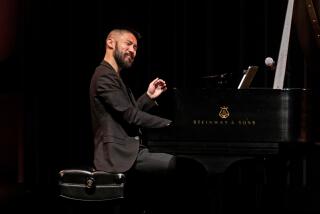Playing First String
- Share via
Musical gifts usually show up early. For cellist David Shamban, the soloist Sunday with Ami Porat and the Mozart Camerata, the gifts became apparent during a grade-school game.
“My music teacher divided the class into two parts and asked the kids to identify the notes,” Shamban said in a recent phone interview from his home in Northridge. “When it was my turn, the game was over because I knew all the notes.”
Shamban was 8.
He was born in the Kibbutz Givat Brenner, near Tel Aviv. There was a small cello there and he was “mesmerized by it at first sight.” But his right hand cramped up soon after he tried to play it.
“The first time you hold a bow,” he said, “you activate a totally different set of muscles. The hand easily cramps up. After two days, I surpassed that.
“After two months of playing, I knew what I wanted to do with my life. I continually surpassed all the students of my teacher. Later on, he switched me to another teacher. I knew I was getting into something I could excel in.”
*
In 1974, Shamban was one of five people selected by the American Israel Cultural Foundation to study abroad. Celebrated cellist Janos Starker had heard him and suggested that Shamban accompany him to study at Indiana University in Bloomington. So off he went.
“The family stayed in Israel,” he said. “It was a big change. When I arrived in Bloomington, I was 21, in 1975. The language was different. People were different. The expectations were somehow met, but different than anticipated.”
Starker, who is still concertizing, turned out to be “a great teacher, simply put.
“He has very high standards for himself and his better students.” Shamban said Starker taught him the crucial mental component of music making. “He teaches you to play what you hear, not to hear what you play. . . . [That’s] important if you’re trying to do something on the string which is an extension of your soul.”
After having studied with Starker for three years, Shamban had to return to Israel. “I had to complete my army duty,” he said.
After a year of that, which he spent in the army’s string quartet, he returned to Starker for another year, then went to Yale for further study with pedagogue Aldo Parisot.
At Yale he met his wife, Kwi-hee Shamban, who is now a professional violinist. They moved to Los Angeles in 1984. “I was out of work, out of money, out of luck and out of time,” he said.
Both Shambans now play in Hollywood recording studios and in various Southland orchestras. They have a 7-year-old daughter, Naomi, who began piano studies about five months ago.
He’s been trying to jump-start his concert career recently. He recorded the six Bach Cello Suites on a CD he produced himself. The label, Reuven-Naomi International, combines the names of his father, who died when Shamban was 13, and his daughter.
“I felt it was like climbing Mt. Everest when I was done. Because of time and money constraint, I did it in two days, six hours a day,” he said. “You can’t splice or cut on these things because you’re the only one: You and the microphone in front of you. But I enjoyed it.”
Shamban will be replacing cellist Vage Ayrikian, who was originally scheduled for the program but who withdrew because of a death in the family.
The solo vehicle, the Haydn Concerto in D, remains the same.
“The Haydn concerto is probably one of the most difficult concertos to carry off because of the style of music, the transparency of orchestration and the high technical demands of the piece,” Shamban said.
“It’s written in a high register. Usually people don’t want to play it because of the intonation problems they incur. But I like this particular piece. It’s very lyrical, melodic and challenging.
“I’m going to write three cadenzas of my own. In this particular style, you’re allowed to. I don’t think Haydn wrote any. Starker wrote one. Of course, you have to adhere to the style and harmonic expectations of the period.”
*
Shamban will be playing the cello that Jacqueline du Pre used in her historic recording of the Elgar Concerto, an instrument made by Sergio Peresson, who died in 1991.
“After she recorded it, she decided to play a Strad and returned it to Peresson, who lived in Philadelphia. Somebody told me about him. I bought it in 1976. It’s tremendous, not like a Montagnana or Stradivarius or Guarneri.
“But people put too much emphasis on the instrument,” he said. “It’s the player. A good player will make any cello sound good. The same with the bow. I used to play with a $60 bow and a $7,000 bow. I asked if people could pick out which was which consistently and they couldn’t. There’s a lot of snobbery in music. If you have an instrument worth $500,000, everyone thinks you’re great. Of course, if you have a good instrument, you have an edge.”
* David Shamban will be the soloist in Haydn’s Cello Concerto in D with the Mozart Camerata led by Ami Porat on Sunday) at St. Andrew’s Church, 600 S. Andrews Road, Newport Beach. The program also includes Haydn’s Symphony No. 22 and works by Vanhall and Dittersdorf. 4 p.m. $23-$29. (714) 250-3131.
More to Read
The biggest entertainment stories
Get our big stories about Hollywood, film, television, music, arts, culture and more right in your inbox as soon as they publish.
You may occasionally receive promotional content from the Los Angeles Times.










